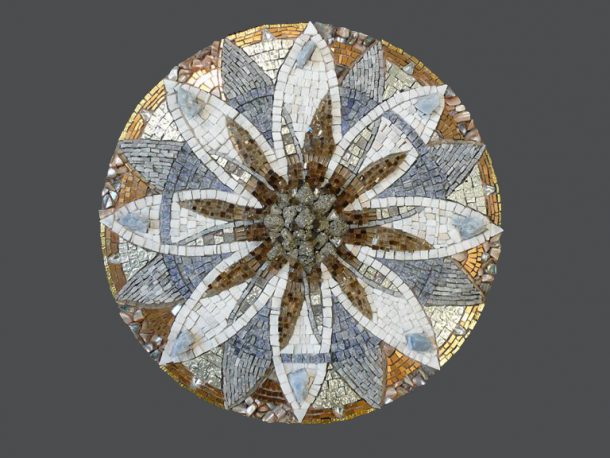
I just returned from a New York pilgrimage to get an audience with the actual object: The Red Book of C.G. Jung. Every Wednesday, the Rubin Museum turns a page , so I got to see two actual spreads. Plates 104-105 and 106-107. Stunning! The majority of the exhibition includes high-resolution facsimiles, pencil sketches, and a few other original paintings in the style of the Book’s plates. I was quite taken with two small chalk pastel landscapes. Jung was a very talented artist of high dexterity. He possessed an extraordinary ability to capture light.
It may take the rest of my life to get through the Red Book. Then, maybe, I will understand something of it, and therefore of myself. Jung’s ability to connect to and describe the inner workings of the soul are unparalleled. Reading his biography, Memories, Dreams, Reflections, I somehow felt less alone in the world by learning of his visions and how he used the mandala as a tool for decoding his inner experience.

Mysterious Creative Powers— a small painting from the exhibition, in the style of the Red Book illuminations
The exhibition is quite small, but The Red Book is displayed center stage, behind bullet-proof glass. The lighting is low, glowing. It definitely has a talismanic quality. I just stood in front of it wondering what hubris it takes to commission a book like this in the first place?
“Yes, I’d like to order a really, really big, 600-page, 100% cotton paper, hand-bound, leather book. And while you’re at it, let’s make that RED leather. Oh, and can you embellish it with lots of gold foil stamping, and why not add a little rose border on the edges too. “
Now imagine— you have the giant leather tome with its gold embossing and thick vanilla pages— already a masterpiece— in front of you, and you have to start drawing and painting on the pristine pages. Page One— Deep breath. Begin…
What many people do not realize is that the book is carefully planned. It is not a “stream of consciousness” effort. The texts were written in several smaller Black Books, then transcribed, carefully edited, and finally, typed up with carbon copies over a period of many years. Jung worked on the Red Book at night after his daily tasks and family responsibilities were complete.

A sketch of Jung's early mandala "Systema Munditotius" from Black Book 5
After years of preparation and pencil sketches, the gouache and calligraphy pens were employed. It took him 16 years to complete the final illuminated manuscript. On the scale of the Book of Kells, Jung’s Red Book work is absolutely precise—an illuminated manuscript for the new millenium. You can purchase a reproduction of the Red Book through Amazon and Barnes and Noble, but alas, it is temporarily out of stock.
Here is a Review from The New York Times, with some good images of the exhibition and examples from the Book.


Thank you so much for sharing your visit!!! It is so inspiring to see what he created, and you brought it into view for all of us!!!
Thanks so much for reading Beth! Great to see you here. yes, the Jung exhibition was a deep experience for me – and it gave me insight into his life work that has me thinking in whole new directions.
Thanks for this wonderful newsletter and sharing these amazing trips and stories!
I started to look for a ticket to go to NY and see the Red Book after I did read your inspiring experience…!
If I’m not going at least will have to get a copy and be illuminated by this intense and beautiful manuscript.
thanks for writing Luz!
Hi, Lillian. As an expat Canadian, I listen to CBC radio on iTunes regularly and came across a two-part radio report on The Red Book that I thought might interest you. The direct link to the CBC Ideas radio show on the Red Book is here: http://www.cbc.ca/ideas/episodes/2012/04/23/the-red-book/
However, you must listen to it while online; if you care to listen to it at your leisure and have an iTunes account, I suggest you locate CBC Radio Ideas under Podcasts and locate the Red Book mp3 files (caveat — you might have to “subscribe” to CBC Ideas before you see older shows, as this show was originally broadcast in April).
Martin
HI Martin, great tip for readers, I’m tuning in now…thanks for visiting the blog!